Northern Ireland: The Joys of Wandering Without a Plan
What started as a sightseeing trip turned into something much better: five days of peaceful detours, warm welcomes, and accidental discoveries.

It is no secret that Northern Ireland has several popular tourist attractions. In the capital city of Belfast alone, there is the Titanic Museum, a Game of Thrones Studio Tour, Saint George’s Market, and several types of “Troubles Tours” to learn about the city’s turbulent past. And of course, outside of town, there is the famous Giant’s Causeway on the northern coast.
As part of our roving retirement, my wife Rita and I recently rented a car and spent five weeks exploring the entire island of Ireland. During one of those weeks in Northern Ireland, we visited several of those tourist spots. But the fondest memories we carry now are of some of the more out-of-the-way places we visited.
For example, after a few days in Belfast, we did indeed head for the Giant’s Causeway. But along the way, we decided to stop and take a break in Antrim. This is not to be confused with the Antrim Coast and Glens, which, like the Causeway and a few other sites, is considered an AONB (Area of Outstanding Natural Beauty). Rather, this is the village on the east coast of Lough Neagh.
It is a small town, just over 25,000 people, and its history goes all the way back to the founding of a monastery in 495 AD. It has a lakefront area of colorful homes, and the Six Mile Water River runs through the town as well. We had no real plans, so when we saw signs for the Antrim Castle Gardens, we decided to take a look.
Parking was free, as was admittance to the Gardens. We were immediately glad we stopped. We walked through the stone archway into a vision of botanical beauty and heritage. We learned later that these 400-year-old gardens are unlike anything else in Northern Ireland. Stunning features include magnificent 17th-century Anglo-Dutch style canals, ponds and avenues, a Victorian Pleasure Garden, large Parterre Gardens, and the Platinum Jubilee Clockwork Garden. Within the heart of Antrim Castle Gardens is the refurbished Clotworthy House.
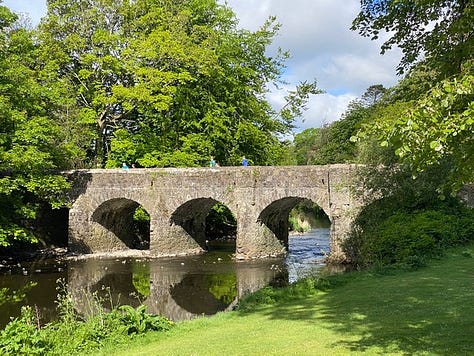

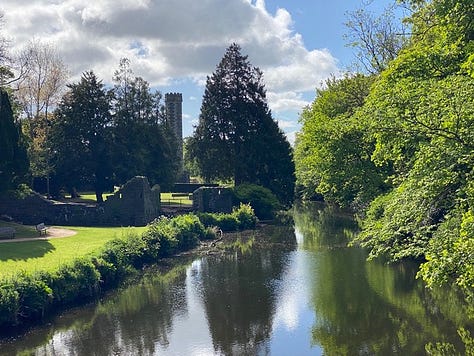
Since this was really just a break from the road, we didn’t take any of the tours offered of the House and Castle. Instead, we joined locals walking the miles of trails, enjoying the gardens and the scenery along the Six Mile Water. A trail connects the Gardens with the town center, so it’s a popular spot for walkers, joggers, cyclists, and moms pushing strollers. Of course, you can’t go far in Ireland without seeing a castle ruin—and indeed, there was an old brick turret to admire.
Dodging Crowds at the Causeway
All too soon, it was time to get back in the car and head to the Giant’s Causeway. While the Causeway is an incredibly impressive geological feature of the island, even though we visited in early May, well before the tourist season, it was still jam-packed with sightseers.
Much more pleasant was our exploration the following morning. After the Causeway, we drove to what would be our home base for the next few days—an Airbnb in the village of Greysteel. Actually, we weren’t in the village itself, but in a three-bedroom home all to ourselves on a farm surrounded by cows, rabbits, and foxes. It was the perfect spot to enjoy the peaceful life of the Northern Ireland countryside.

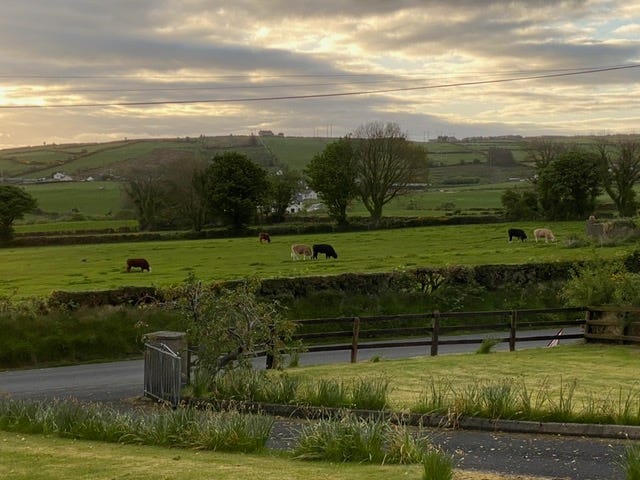
Portstewart Surprises and Dunluce Delight
Our first day trip was again mostly unplanned, just based on looking at maps and deciding what might be interesting. We chose to head north to the coast and check out the village of Portstewart on the North Atlantic.
Portstewart is a charming fishing village with some beaches, but as we’ve learned, things don’t always go as planned when you’re roaming. In this case, we happened to show up in what we thought would be a sleepy little coastal town on the day before a huge Monaco-style motorbike race through the city streets was to begin. There were stands being set up along the race route, ESPN signs everywhere, and fields full of camper vans and RVs. So although it looked like a lovely place to visit, and we did catch a glimpse of the coast and beaches, traffic was building quickly. We chose to move on to something else we had spotted nearby on the map—Dunluce Castle.
Once again, a random stop turned into an unforgettable experience. Also on the North Atlantic coast and only a few miles west of the Causeway, Dunluce Castle turned out to be a fascinating stop. The ruins sit on high basalt cliffs and are in two parts, connected by a bridge. The seaside views are as fantastic as any you’ll find in Ireland. In fact, the coastline is so dramatic the castle was used for exterior shots of Pyke Castle on the Iron Islands in the Game of Thrones HBO series. Although the castle itself was CGI-enhanced to look whole, the steeply dropping cliffs are just as they appear in person.
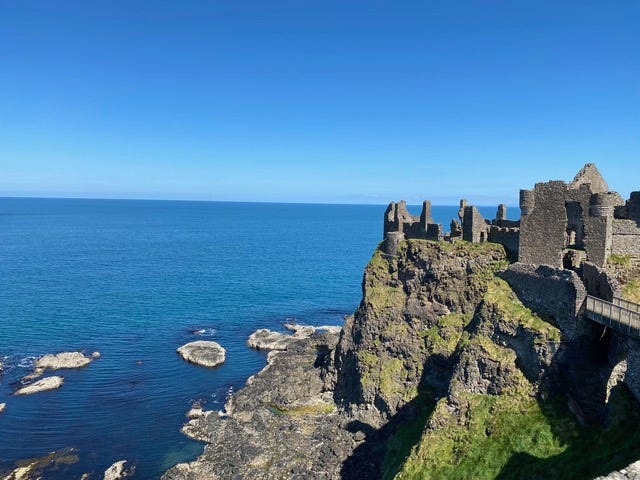
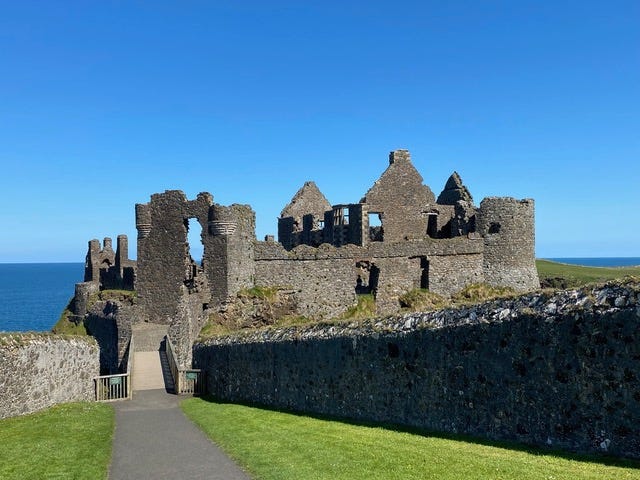
Better yet for us, there were hardly any tourists. We walked the grounds and explored the castle and exhibits without the press of crowds, often with no one else in sight. Parking again was free, with only a £6 admission fee to the site itself. It was well worth it, as we enjoyed a step back in time, marveling at the walls still standing and hearing only the wind, the sea birds, and the cows lowing in neighboring fields.
On our way back, asking our GPS for the nearest lunch spot led us to another great find—the Bushmills Inn in the nearby village of Bushmills. If the name sounds familiar, they are also the distillers of the Irish whiskey of the same name. We had a delicious meal in a pleasant country setting, and my only regret is that since I was driving, I couldn’t sample their most famous products.
Walking the Walls of Derry
One last day trip in Northern Ireland that turned out to be something special was a visit to Derry. It’s not as popular a tourist destination as Belfast, although its history of struggle against British rule and conflict between Catholics and Protestants is just as dark. I must confess we were mostly interested in seeing it because of the TV series Derry Girls. The city takes advantage of this, with Derry Girls murals, tours, and souvenirs abounding.
This time our timing was better. Instead of motorcycle races, the city was hosting a jazz festival. Everywhere we walked around town, we found not only architecture to admire but also groups and solo artists performing every few blocks.
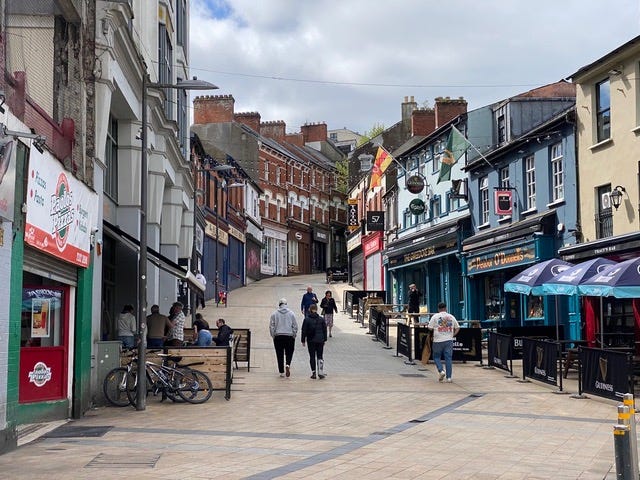
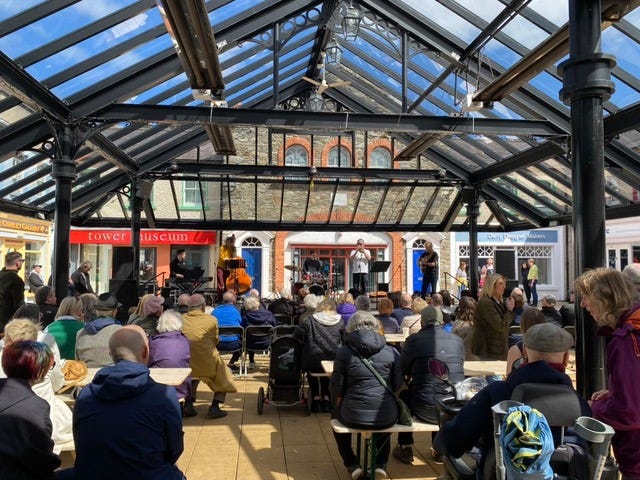
Derry is the second-largest city in Northern Ireland and is known as the only remaining city in all of Ireland with completely intact city walls. The Walls were built in 1613–1619 by The Honourable Irish Society as defenses for early 17th-century settlers from England and Scotland.
One of the sites we visited, the Guildhall, chronicled the complicated and chaotic history that made the walls a necessity in the 17th century, as England began sending Scottish settlers to take over land and set up plantations to benefit the Crown at the expense of the Irish. Locals found themselves in the position of having to rent their own land in order to farm.
Today, the walls are an engineering feat to marvel at, and a great spot to enjoy the stunning panorama of the surrounding land and the River Foyle. Inside the walls, there are wonderful shops, and of course, we had several pubs to choose from before heading out to enjoy a little more jazz and then return to our farmhouse.
Roving Reminders
Looking back, our time in Northern Ireland was a reminder that although there is nothing wrong with enjoying typical tourist attractions, we often find that the things we remember more fondly are the unplanned and off-the-beaten-path destinations in our roving retirement.
— Jim Santos, IL Roving Correspondent.
Editor’s Note: If this story makes you curious about what daily life could really look like in Northern Ireland—from the friendly villages and historic cities to the peaceful rhythm of the countryside—don’t miss International Living’s full report: Discover Northern Ireland: Culture, Community, and a Slower Pace of Life. It’s packed with insights on the cost of living, healthcare, visas, and where to live.


